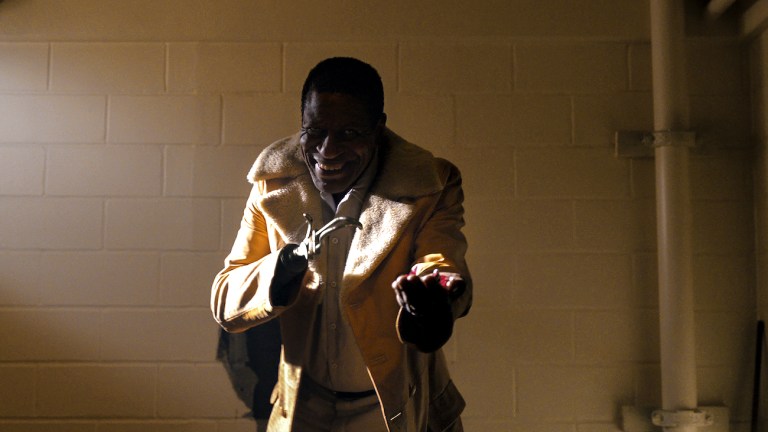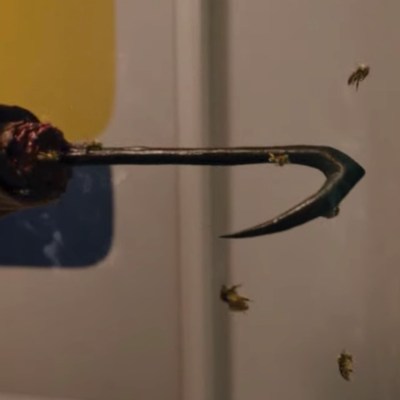What the Candyman Ending Means for a Sequel and His Immortal Legend
Nia DaCosta and Jordan Peele reimagine the Candyman legend and paint a bloody finale which promises a very different kind of sequel.

This article contains Candyman spoilers.
It is an exquisite final image. Swarmed in a symphony of bees and standing triumphant over his latest victim—a police officer sprawled out in an alleyway’s gutter—Candyman looks joyful. He’s the monster who’s haunted the ruins of what was once Cabrini-Green for more than a hundred years, and the legend who frightened children and caused lovers to cling closer in their rapture, and now he’s at last returned to his flock. Only this time Candyman is saving the woman who summoned him instead of destroying her.
As Teyonah Parris’ Brianna Cartwright looks on, her salvation is a wondrous thing—both a ghost and a living ghost story—who has killed something far scarier than his legend. The truth of this is told by the bodies of corrupt police officers strewn around the scene. Moments earlier, those same cops in cold blood killed Brianna’s boyfriend, artist Anthony McCoy (Yahya Abdul-Mateen II), after assuming from a glance this Black man was the criminal they sought. In doing so, they permanently secured Anthony’s place in the Candyman mythos, crafting his sad story onto the enduring larger one written in blood by the Black bodies that’ve been destroyed on these lands for more than a century. So when Brianna summons Anthony back by saying “Candyman” five times, it is not Abdul-Mateen’s face we see. Rather a de-aged Tony Todd stands defiant again. The everlasting saga of the Candyman walks again among us.
It’s a loaded image that speaks greatly about the movie we’ve just watched… and the inevitable Candyman sequel we are about to get.
Because rest assured, there will be a Candyman 2 (or Candyman 5, if we’re getting technical). After all, this new movie just grossed an impressive $22.4 million in its opening weekend, which nearly matches the film’s entire $25 million budget. There is thus little doubt about whether Universal Pictures will want to continue the story. But of course the entire point of Candyman is that this is a story which never ends, not in the last vestiges of Cabrini-Green, and not in America. All of which makes the prospects of another movie fascinating…
A New Candyman for a New Type of Victim
If Bernard Rose’s original Candyman (1992) was a Gothic Romance of the nihilistic order—complete with the loaded imagery of a Black man haunting the dreams of a white woman—then Candyman circa 2021 is functionally something else. At its barest bones, it’s a werewolf movie, and a Jekyll and Hyde reimagining. Abdul-Mateen’s Anthony is a good man who says his prayers by night (or at least kisses Brianna before bed), but when the moon rises, and “Candyman” is whispered five times before a mirror, something supernatural and beyond his control takes hold.
If Virginia Madsen’s Helen was bedeviled by the assumption that she was responsible for Candyman’s murders in the original movie, Anthony is damned by the much worse realization that he is becoming Candyman. Of course the idea of what that means is something far more tangible than urban legends about mirrors and spirits.
As eventually explained by Colman Domingo’s William Burke, Candyman is more than just a ghost story; it’s the tale of systemic oppression of Black men since time immemorial. The original Candyman might’ve been Daniel Robitaille, a Black artist in 1890s Chicago who dared to fall in love with and impregnate a white woman—which led to his body being mutilated by a lynch mob—but as Burke explains in Candyman, all those innocent Black men who’ve been brutally murdered by white authority over the decades were real men who existed beyond the confines of campfire stories. They lived, they loved, and they died horrible, gruesome deaths. In the case of Burke’s own childhood boogeyman, Sherman Fields (Michael Hargrove), that came in the form of a simple neighborhood man who liked giving candy to children, and the cops naturally assumed he was responsible for the recent death of a white child before shooting him.
These real stories are twisted into an urban legend that shrouds the ugliness under a veneer of Gothic horror and romance. That is the true tragedy of Candyman. Hence the horror of Anthony becoming just another Black face to fear for those with the power, another boogeyman whom cops will eventually shoot on sight simply for being in the wrong place at the wrong time. Society is literally forcing and contorting these Black men’s bodies to fit a prejudiced assumption.
That is why, according to Burke, and by extension Nia DaCosta and Jordan Peele’s script, the Candyman story lives on with a mystical sort of power. Throughout the movie, Anthony McCoy is haunted by Candyman’s reflection in the mirror, even though we rarely get a good look at him. The role of a monster is being thrust upon him.
Yet who does the revived Candyman kill? Whereas in the original film he considered the impoverished residents of Cabrini-Green’s projects his “children” and “flock,” whom he occasionally would select victims from to keep his legend alive, the Candyman of 2021 has few Black faces to cull from. Gentrification has literally pushed them out, and the high-rises Rose and Tony Todd shot the original Candyman in have been torn down and erased.
So Candyman’s victims in the 21st century are largely the white faces who’ve displaced the original flock. Tellingly, the first victim in the new movie is Clive Privler (Brian King), a white man who curates Black art and generates wealth for himself by exploiting local trauma. What sets Anthony on his fateful descent is being told by Clive that art about Black struggle in the South Side is played out; dig into that Candyman nonsense in Cabrini-Green instead. So it is that Clive and his girlfriend, who pay no credence to the rituals and awe Cabrini’s previous residents had for Candyman, are among the first to summon the ghost—tasting his glorious treats.
The next victim is a white art critic who has little interest in Anthony’s art when she first sees it. Rather she has the chutzpah to tell a Black man about why he is guilty of gentrification and dismiss his art as blunt and common. Yet when she sees commercial appeal in the story following Clive’s gruesome murder—suspecting there is now a Black story to benefit from telling herself—she circles back to Anthony’s Candyman art and seals her fate.
In the original Candyman, Tony Todd purrs, “They will say that I have shed innocent blood. What’s blood for, if not for shedding?” In 2021, no one who dies by Candyman’s hook is particularly innocent. Even the teenagers who summon him to a high school bathroom have benefitted from a culture that relies on complicity. They were of course too young to know they’re part of that system… but then so was Anthony when he was taken as a baby by the Candyman 30 years ago, and doomed to the same cyclical violence perpetrated against Black men each generation. Innocence and ignorance save none in this story we’ve built for ourselves.
Which brings us back to that ending with Anthony dying so as to fully resurrect Candyman’s legend. As Burke plainly spells out, a ghost story for Black communities could be laughed off by the elite and bourgeois white classes in the past. Now Candyman can live forever if the blood he is spilling belongs to white culture—beginning with the cops summoned to the scene.
Where Does This Leave the Candyman Sequel?
The last line of the new Candyman is Tony Todd’s visage commanding Brianna to “tell everyone.” He’s back. The full impact of that is revealed during Candyman’s end credits. Initially, the film fades out on DaCosta’s use of haunting paper shadow puppets, which were used throughout the movie to recreate old myths about Candyman: Helen Lyle’s fate and Daniel Robitaille’s courtship of a wealthy white daughter and a father’s terrible vengeance. Yet if you stay long enough in the theater, a new shadow play is enacted, one in which an artist loses his mind, and his paint brush is replaced by a hook.
This puppet play ends like the movie: Candyman has risen and five treacherous police officers are left in pieces. The implication is, clearly, that Brianna has obeyed Candyman’s edict and spread the good word.
Yet if this is the new legend, where can that lead a potential follow-up? Is Candyman essentially a superhero movie? The story of a ghost who punishes those white faces that dare dismiss the Black culture they’ve supplanted and profited from?
Possibly, although I think that is too reductive and simplistic for DaCosta and Peele, as well as somewhat of a betrayal of Candyman’s appeal if it stops there. Like the beautifully haunting melody of Phillip Glass’ original Candyman musical theme, there is an intoxicating allure found in the sorrow and tragedy wrought by this character. If Candyman’s story is transitioning from one about meta-textual mythmaking to one about cultural revenge against repression, then it must still remain a revenger’s tragedy.
As Burke said in the new movie, Candyman is a tale folks use to comprehend and organize their thoughts around long systemic violence against Black people in this community, beginning with Daniel and carried on through Anthony in this particular case. That story is, sadly, unending in American life, but it can be told in a new way by a Candyman sequel.
If the 2021 movie is, in its barebones, a werewolf narrative with a central victim coming to terms with his transformation, then a follow-up could pivot to returning to the heightened operatic quality of the original Gothic film. For instance, as brutal and merciless as DaCosta’s on screen violence is in the new picture, I would argue there is nothing as unnerving or unforgettable as Tony Todd’s big entrance in 1992.
Halfway through the original movie, after being told repeatedly there is no such thing as Candyman, Helen and the audience eventually turn the corner in a parking deck and there he is: formally draped in a fashionable coat and standing at a posture that is simultaneously inviting and foreboding. He’s no slasher killer who will float across the floor to get you. He is an almost godlike presence who has the infinite patience of a spirit that knows time is on his side, and his reach is inescapable. The more Helen attempts to resist, the more she and the audience are helplessly drawn in by the irrepressible power derived from a legend.
A sequel to Candyman (2021) could lean into those abilities and allow Abdul-Mateen to fully inhabit the role in the way Todd did for a previous generation. Abdul-Mateen certainly has the talent to use a soft-spoken voice to dominate the screen. However, the trick could be to use it to a different end.
With Candyman returned as a spirit of revenge against a white society that has finally grown forgetful enough to move into his domain—the ruins of Cabrini-Green—he can now be a presence that at last victimizes those who oppressed Daniel Robitaille, Anthony McCoy, and all the others. By virtue of that long sad history, the melancholic fatalism of the character can never feel empowering… but it can be righteous.
Anthony becoming the face of Candyman for this new era makes sense as the story of the artist’s madness and demise is now forever coupled to the legend. Just as Anthony saw Sherman Fields in the mirror because William Burke told him the Candyman story of his youth, so will new generations see Anthony McCoy when they dare summon Candyman.
And if Anthony is the face of Candyman going forward, he can continue to haunt Brianna’s dreams while drawing her into providing him more victims—sweets for the sweet—which would recontextualize the fatalist romance from the original movie. Theirs could be the ultimate art piece in the new Candyman’s mind, one where he cuts a bloody canvas so vast that even Lakeshore Drive cannot look away. How delicious.

